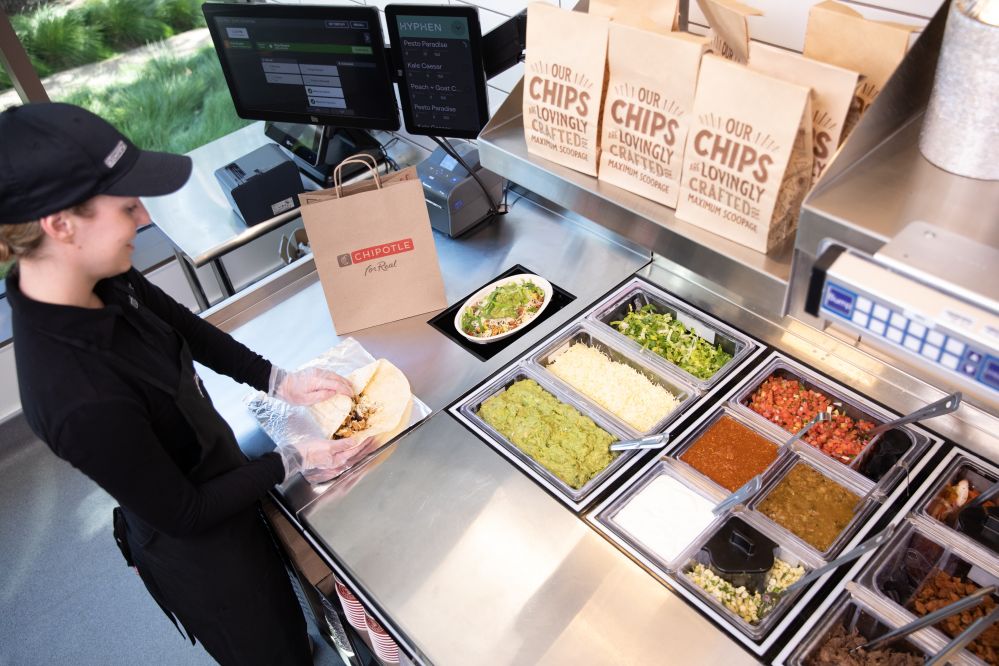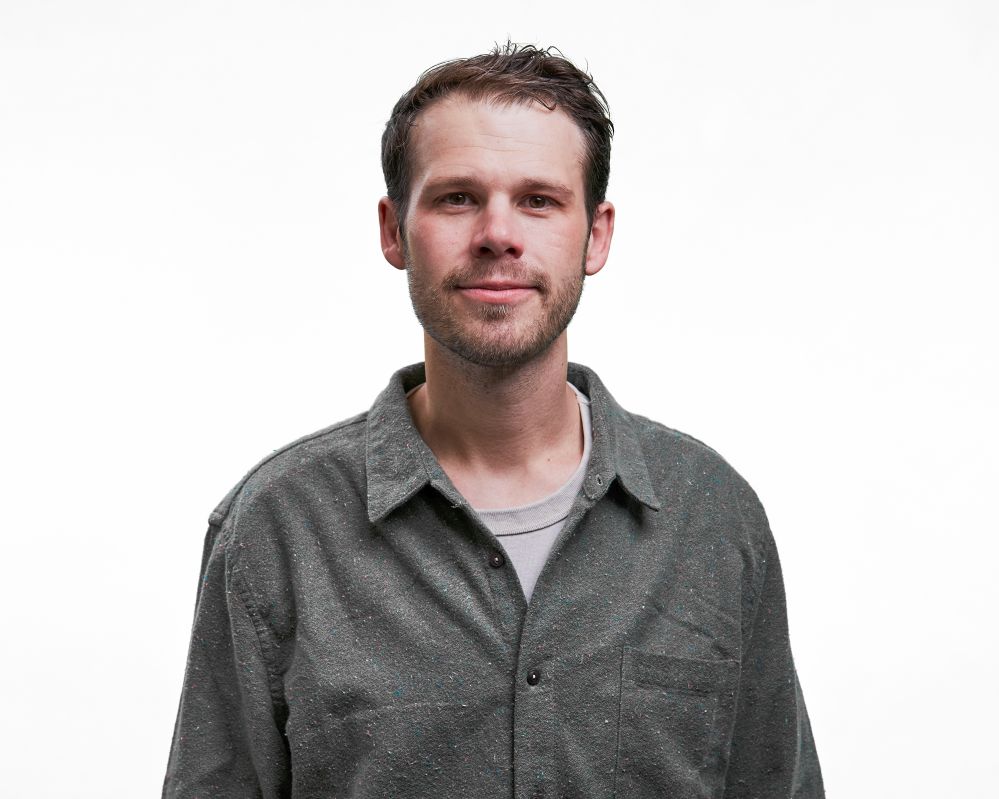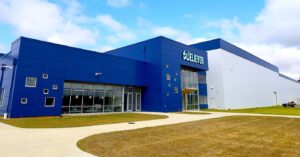[Disclosure: AgFunderNews’ parent company, AgFunder, is an investor in Hyphen.]
Robots—especially the ones with articulated arms that you might see in Tesla plant—are pretty cool, says Hyphen cofounder Stephen Klein, who had his first, “humbling,” encounter with ‘bots at Bay area based ‘robotic coffee bar’ startup Café-X in 2016. But there’s a time and a place, he says. “Turns out you actually don’t need a 30-kilo robotic arm to move a coffee cup.”
If you’re operating an assembly line or ‘makeline’ in a fast-casual restaurant or salad bar with a high percentage of online orders, however, getting a machine to prepare these orders either in the backroom or under the main counter makes obvious business sense, he says.
Engaging robots to prepare customized meals can cut labor costs, improve accuracy, portion control, and inventory management, and potentially provide a meaningful boost to revenues by enabling operators to fully capture demand at the busiest times.
Hyphen’s robotic system, The Makeline, has two parts: a top portion where staff manually prep in-person orders, and a lower portion that automates the assembly of bowls, salads, and similar items for online orders.
AgFunderNews (AFN) caught up with Klein (SK) to talk about the highs (‘We were cold-emailed by Chipotle’) and the lows (March 2020: ‘It was probably the hardest time of my life’) of running a startup, and why you don’t need a robotic sledgehammer to crack a nut.

AFN: How did you get into the world of robotics and foodservice?
SK: I’ve always been obsessed with food and foodservice and very into tech, so I decided to start a frozen yogurt shop [text-to-deliver ‘Fro Yo at the Vue’] with a couple of my buddies in college, which was a very humbling experience…
After that, I left school and joined Instacart [in early 2014] after they closed their series A [in 2013] when they only had about 30 employees, so I wore a lot of hats, mostly on the product ops side. I worked on the shopper app and I really loved it, but we pretty rapidly went from 30 people to about 500. My wife would say I’m a masochist, but I kind of wanted to do something earlier stage, which led me to [a startup called] Café-X [San Francisco-based robotic coffee bars].
A lot of my job there involved navigating the Byzantine world of government regulation and dealing with permitting in the Bay area, which was also a pretty humbling experience! But we ended up getting the first cafe approved in San Francisco, which I think was the first ‘robotic restaurant’ approved in the US, so that’s pretty neat.
I think I learned a lot about what not to do there. Effectively it was a block with a robotic articulated arm, and it turns out you actually don’t need a 30-kilo robotic arm to move a coffee cup… it’s the same thing you might find in a Tesla factory, so it just kind of seemed like overkill, although I did learn a lot about profitability in foodservice.
But that’s where I met Daniel [Fukuba], my cofounder at Hyphen, who was at LTF [providing robotics, automation and AI solutions for the foodservice industry] and we decided to join forces.
AFN: Tell us about the genesis of Hyphen (first known as Ono Food Co)
SK: We built a fully robotic food truck for making smoothies in about 15 months with five people and $2 million. We were what I’d call automation maximalists, so everything end-to-end was automated. It was going really well, we were operating this truck in Los Angeles in high traffic areas and we also built our own app, so people could order their food in advance and pick it up after a workout, for example.
Part of the excitement was that people could actually see the products being made, which I also saw at Café-X, but I’d say the novelty wears off pretty quickly. What matters is if your food is good, we get your order right, and it’s at the right price.
AFN: So everything was going great. And then the pandemic hit?
SK: It was probably the hardest time of my life. My wife was living in London at the time and I just remember walking down Abbot Kinney [Boulevard in Los Angeles] the day after the stay-at-home order from the governor and it felt like I got a kick to the stomach. We were just a few months into launch and the place was a ghost town.
We ultimately made the very difficult decision to pause and then ultimately cease operations and we had to lay off our staff. But it was also a kind of come to Jesus moment with Daniel. We had been talking to [salad chain] Sweetgreen about licensing our IP for some time was before [it acquired kitchen robotics startup] Spyce and I thought to myself, what if we just took the guts of what’s in this smoothie truck and put it underneath the countertop of a makeline that most fast casual brands have? And that was ultimately the genesis of Hyphen.
So at that time it was just me, Daniel, Lucy [Augusta Voigt, VP culinary operations] and Carter [Branch, then director of partnerships] and I was taking our makeline concept to restaurant groups and food service providers and saying, ‘If we take this concept and package it for you, would you pay this much?’
And we basically got contracts signed with commitments to this number of units if we hit this throughput, hit this portion accuracy, this amount of uptime, and so on, and then we used that to raise some capital, hire critical folks and start building.
AFN: So how does it work?
SK: So a customer places an online order through DoorDash or whoever, and dispensers precisely portion food according to the precise customer spec into a bowl or tray or food container that moves along the line. And once it’s complete the filled bowl goes up an elevator for pick up at the end. We have hot cabinets, cold cabinets, and ambient cabinets, each with their own temperature gauge.
The feeders are agnostic to the ingredient type, which is really our core IP, because if materials are consistent, it’s easy to automate processes, but in our case, there are nearly infinite kinds of ingredients that could be dispensed with very different material properties, so we had to use sensors and computer vision and ultimately AI and ML to auto tune these ingredients as they dispense or feed.
And then each robotic little arm has a scale that can measure down to the gram.
AFN: How has the system evolved?
SK: It’s evolved, so as one example, in the first generation we had something almost like a fuel gauge on your car that tells people how many miles or in our case meals you can make with a given ingredient before you have to refuel or restock.
But what we found after operating with customers was that this was useful, but all they really need to know is when the dispenser is out of an ingredient and needs refilling, so we made it gently illuminate when it was empty to grab the attention of the staff member. If there’s a blue ring around kale, they know the kale container is empty. But the line cook needs more information, so they have a little tablet almost like an iPad that will say, ‘You need to get started on [cooking/preparing] X amount of Y ingredient by Z time.’
AFN: What are the metrics that matter in this kind of operation?
SK: Throughput—how many meals you can make an hour—obviously matters. And then accuracy matters in two ways. First, that the orders are correct and people get what they ordered, but second, because portion accuracy is critical for consistency, managing food waste and inventory management.
As for the reliability of the machines, the metric is OEE, or overall equipment effectiveness, and it’s effectively looking at three things. Uptime, performance, and quality. We’re at over 95% at this point, with 99% uptime.
AFN: How does maintenance work for your machines?
SK: Most of the potential issues, we’ll know in advance, because the system is fully instrumented, and we’re constantly monitoring the machines. But in the instance that there’s a component that breaks or goes down, every single component on the makeline can be replaced in the field with four screws. We have a field service contractor that can go to our customers and fix any issues like this very rapidly.
AFN: Where do robots make sense, and when are they an expensive boondoggle?
SK: I see people looking at what I call the ‘white knight’ solution, for example using an articulated arm, which is easy enough to program, but is highly inefficient in two ways. One, it’s just too expensive, so you need massive economies of scale, and two, it’s very big, as you need a console to power it, and it needs to be protected for safety reasons. You’d basically need six of those robotic work cells, or something the size of an apartment, just to get the throughput of one of our systems.
Our system is the inverse of that in that it is purpose built for foodservice, so when we go to install it at a Chipotle makeline, there’s zero retrofitting. So I’d say it’s more like an appliance as opposed to a robot in that you install it and it just works.
Our system is gravity fed, but the dispensers are also robots, and they have to meter out an ingredient precisely based on its characteristics. If it’s leafy greens it’s more like a shutter door or trapdoor, whereas if it’s something viscous like peanut butter or guacamole or sour cream, it’s a paste dispenser, whereas for a dressing or hot sauce, we use more of a piston fill, which is a different kind of feeding mechanism. So each food pan has its own robotic system in it.

AFN: How flexible is the Hyphen system? What if a customer changes its menu?
SK: We can auto dispense almost any ingredient, and so operators can basically go into our culinary OS [operating system], which has a menu manager function, and they can drag and drop in new ingredients, and we can recalibrate things for them.
AFN: What can’t your machines do?
SK: Very delicate products like fanned avocado or flaky salmon filets are hard, but these are the kinds of things that if the machine does everything else, a [human] operator can add those finishing touches at the end.
AFN: What’s your business model?
SK: Rather than asking people to pay upfront to buy the tech, it’s RaaS [robotics as a service]. It’s basically subscription-based pricing based on the production volume customers do per year. So we look at annual unit volume—what does one store or restaurant on average do a year— and then they fall into a pricing tier. There’s a small upfront free for transportation and installation, but they’re not buying the machine.
AFN: Who is the target customer and what’s the ROI?
SK: Restaurant chains with makelines and big contract foodservice providers like Compass Group or Aramark.
On the restaurant side, we’re definitely reducing labor costs and improving inventory management [which helps to reduce food waste], while for customers like Chipotle, being able to deliver a consistent experience is really, really important. But it’s also about increasing revenue by being able to fulfil orders at the busiest times. If we can provide more throughput, our customers can capture the full demand, as many of these types of operations will have a couple of super-busy periods and then long periods where staff aren’t doing much.
AFN: Is there a sweet spot where your system makes economic sense?
SK: If you’re a restaurant chain, it only makes sense if you have a certain percentage of digital volume [online orders], so Hyphen can take care of those while you [the human staff] handle in-person orders. But if you’re a commissary kitchen, we’re enabling new use cases so things like pre-preparing hundreds of grab and go salad bowls, where an operator might [historically] come in and make 500 of these a day and then place them around university campuses but then also do front of house service as well.
Another use case is at sports or entertainment stadiums, such as the Kia Center in Orlando, Florida, where all of your revenue might be made in this crazy period during half time, where they’re doing something like $400,000 in food and beverage sales in a 15-minute period. If we can increase the throughput, we can increase revenue.
AFN: What progress have you made to date?
SK: Industrial automation is still very new in the restaurant world, but we’re all over the country now with close to 30 systems operating, from the Kia Center in Orlando to the University of Las Vegas to Santa Clara square. But this past year has been all about focusing on the big three: Chipotle, Aramark, and Compass Group.
We’ve also improved our system, so now we’re in the process of upgrading existing customers to our generation 2 model.
All I can say about Chipotle right now is that things are going well and we’ll be able to say more soon!
AFN: How have you funded the business?
SK: We’ve raised $58 million from investors including Chipotle, Tiger Global Management, AgFunder, Toast co-founder Steve Fredette, and Donald Moore, former chief culinary officer at The Cheesecake Factory, and we’re currently raising our series B round.
AFN: What was it like when you first heard Chipotle might be interested?
SK: I think it was around April 2022 when I got cold emailed by someone connected to Chipotle and I had a call with the CTO Curt Garner on a Friday and he said, ‘Can I see your system in action?’ So I said great, maybe next week? And he said, ‘How does Monday work?’
So I say, ‘Sure, that works,’ and then I call Lucy and ask her to buy something like $3,000 worth of Chipotle catering because we hadn’t run their food on our makeline system before. Daniel came over and we ran Chipotle’s food on our system and it ran really, really well. So on Monday, the execs flew in and watching them see our system using their ingredients was definitely one of those kind of ‘pinch me’ moments!




